Ghost Cats & Blind Masseurs
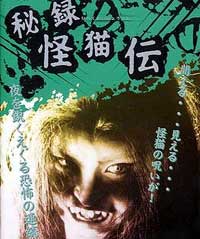 Often a kaidan or Japanese period ghost story regards a supernatural cat, a blind man, & a ghostly woman, all elements in Tokuza Tanaka's Haunted Castle (Hiroku Kaibyoden, Daiei, 1969; two illustrations are shown here for this film. Often a kaidan or Japanese period ghost story regards a supernatural cat, a blind man, & a ghostly woman, all elements in Tokuza Tanaka's Haunted Castle (Hiroku Kaibyoden, Daiei, 1969; two illustrations are shown here for this film.
Haunted Castle opens in 1729. Lord Tangonokami Nabeshime (Koichi Uenoyama) of Saga Prefecture takes a fancy to a blind monk's sister, Sayo (Mitsuya Kamei).
Monk Matashichiro (Akihisa Toda) lives on a small "sympathy allowance' of 3,000 koku (rice tax) of land, though once his clan dominated the region. Though he has fallen on hard times, he nevertheless refuses to bow to Lord Nabeshime's lecherous interest in Sayo.
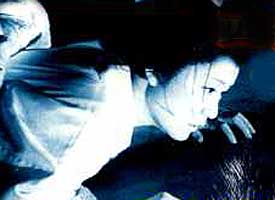 During the monk's regular game of Go with the Lord, Matashichiro detects the effort of his Lord & lord's chamberlain (Mutsuhiro Toura) to cheat at the game of Go, but the chamerlain denies having removed a piece from the gameboard. During the monk's regular game of Go with the Lord, Matashichiro detects the effort of his Lord & lord's chamberlain (Mutsuhiro Toura) to cheat at the game of Go, but the chamerlain denies having removed a piece from the gameboard.
The lord & chamberlain ultimately kill the monk, whose dying words are, "It's unforgiveable!" At the same moment, in the temple, Sayo sees a string break on the blind monk's lute, an ill omen. The chamberlain has the monk's body dumped in a well & the well filled up with sand.
Tama, the black cat which had tried to keep the monk from leaving the temple in the first place, brings a bloodied bit of cloth to Sayo, which she recognizes as part of her brother's clothing. Sayo, ordered to leave Saga the next morning, commits suicide by cutting open her stomach, asking the cat Toma to lap her blood as she dies so that the cat can gain supernatural powers & curse the castle.
Komori (Kojiro Hongo), a sympathetic vassal, tries to resolve the mystery of the monk's death while divesting the castle of the murderous ghost-cat. The cat first possesses the body of a lady-in-waiting who becomes a grotesque female spirit killing innocent women in the castle.
Vassal Hanzaemon Komori manages to slay the possessed woman, but the spirit merely takes over Lord Nabeshime's wife, Toyo (Naomi Kobayashi), & the Lord grows ill from making love to her during her possession.
[SPOILERS ALERT!] An exorcism ends in the death of several priests. Vassal Komori elicits the aid of the temple's abbot in obtaining a shirt inscribed with protective sutras, which he will wear while battling the ghost-woman. She manages to slay the evil chamberlain but Komori saves his Lord's life, there being no final revenge in this case.
The scenes when the cat-ghost-woman is leaping & skirting along the roof, with two spears hanging from her flesh, are spectacularly horrific. At cost of many lives, Komori finally succeeds in killing the spirit permanently, & the dead body of the cat Tama is found dead upon the well where the blind monk was buried.
Lord Nabeshime gives up his sexual excesses & reinstates the monk's family, sending Komori off to find the heirs of Sayo & Matashichiro. [END SPOILERS]
The elements which are common to so many samurai & ghost films are the blind victim, a supernatural cat, & frighteningly grotesque female ghosts who float around murdering with supernatural strength, though often justified or tragic rather than merely creepy.
Even the modern J-horror cinema is riddled with such images of tragic female ghosts with long hair, who might actually be appealing in their periodic beauty, if they weren't so damned deadly.
Though riddled with convention, Tanaka's Haunted Castle is superb-of-kind, gripping & tense from beginning to end, with an awesome transformation sequence. it does not resolve only in simplistic revenge as do most such tales, but adds an element of penitence.
The hero of the piece must balance his feelings of real justice against his responsibility to defend a lord whose actions started all the grief, a dilemma that is resolved by "lessons learned" rather than avoided by the easier ending of having everybody killed off. The film takes on a feeling of actual legend rather than exploitative or commercial cinema.
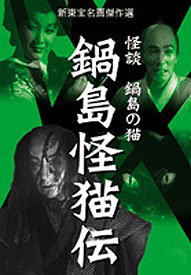 An earlier version directed by Kunio Watanabe is also available on DVD, Ghost Cat of Nabeshime (Nabeshima kibyoden, Shin Toho, 1949).
An earlier version directed by Kunio Watanabe is also available on DVD, Ghost Cat of Nabeshime (Nabeshima kibyoden, Shin Toho, 1949).
It is more artful with deeper characterization, starring Denjiro Okochi, Yotaro Kurokawa, & Michiko Kogure. A poster for this version is at the very top of this page, besides the box shown here for the unsubtitled dvd.
The setting for the legend of the Saga ghost cat shifts a bit from film to film, but was originally inspired by an historical event of 1590 in Saga prefecture, the time of the "Nabeshime sodo" or "Nabeshime disturbance" when Naoshige Nabeshime (1538-1618) oversaw the execution of a man & woman for adultery, & rumors spread afterward of appearances of their ghosts.
When kabuki playwright Joko Segawa III took this up as his subject for a play, he added to the historical backdrop a "bakeneko" or demon-cat, otherwise "kaibyo" or ghost-cat, & debuted the play Hana Saga neko mata zoshi (Cat Demon Legend of the Flowered City of Saga) to rounding success in 1853.
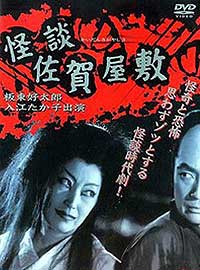 The story began to be adapted from the kabuki play to the screen as early as 1910 & almost annually throughout the silent era, & by the 1930s a continuous string of talkie versions were released. The story began to be adapted from the kabuki play to the screen as early as 1910 & almost annually throughout the silent era, & by the 1930s a continuous string of talkie versions were released.
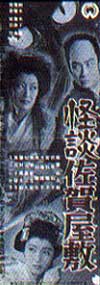 Many versions of the tale of the Nabeshima ghost disturbance were filmed along the decades, a few of which have made it to the import video market, including Ghost of Saga Mansion (Kaidan saga yashiki, Daiei, 1953) directed by Ryohei Arai. Many versions of the tale of the Nabeshima ghost disturbance were filmed along the decades, a few of which have made it to the import video market, including Ghost of Saga Mansion (Kaidan saga yashiki, Daiei, 1953) directed by Ryohei Arai.
There are three illustrations for Ghost of Saga Mansion surrounding these paragraphs, the jewelbox of the digitally remastered dvd, a contemporary poster, & a still of the ghostly catwoman.
Ryohei Arai on the basis of this film & to a lesser degree Ghost Cat of Arima Palace (Kaibyo Arima goten, 1953) would seem to have been a minor genius though largely forgotten & evidently never prolific.
He directed another bakeneki-mono, Spirit of the Cat (Shinrei jakuneko, 1940), the kaidan ghost story Mansion of Death (Shibijin yashiki, Daiei, 1954), & a handful of other sorts of films, including short silent films preserved by the Matsuda Film Institute in Tokyo.
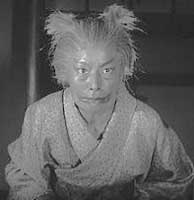 This masterful version starred Bando Kotaru as Vassal Komori Hanzaemon who battles the demonic cat, & Takako Irie who plays the vengeful cat-ghost Otoyo. This masterful version starred Bando Kotaru as Vassal Komori Hanzaemon who battles the demonic cat, & Takako Irie who plays the vengeful cat-ghost Otoyo.
Takako rather specialized in ghost-cat roles & was a major box-office draw in numerous cat-ghost legends.
Takako Irie's popularity in cat-ghost roles was rivaled only by Sumiki Suzuki in the 1930s. Both actresses seem to have covered all the basic cat-ghost legends at one time or another, & Suzuki's first outing in such a role was for the familiar Saga cat-ghost in Saga kaibyo-den (1937) directed by Mokudo Shigeru.
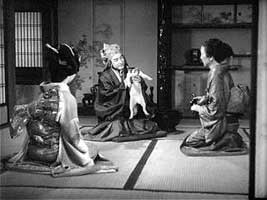 Quite a few other films tackle the theme of the cat of the "Nabeshime disturbance" but about most of them I know little or nothing, & some of which perhaps do not survive. I will merely list a few: Quite a few other films tackle the theme of the cat of the "Nabeshime disturbance" but about most of them I know little or nothing, & some of which perhaps do not survive. I will merely list a few:
Nabeshima kaibyo-den (Legend of the Nabeshima Cat Ghost, 1929, silent) directed by Shiroku Nagao; Kaibyo Saga no yozakura (Cat Ghost & Cherry Blossoms at Night in Saga,1930, silent) directed by Minoru Ishiyama; plus quite a few other silent versions.
Among talkies: Kaibyo-den (Ghost-cat Legend, 1938) directed by Kanji Suganuma; & Silver Cat's Curse (Noroi no ginbyo, 1939) directed by Kanenori Yamada.
The Saga ghost cat legend certainly is not the only one that includes the vengeful ghost or curse of a blind person. The Blind Woman's Curse aka Black Cat's Revenge (Kaidan nobori ryu, 1971) pits a blind swordsman against "the dragon tattooed lass" assisted by a cat-demon.
The long-running series about Zatoichi the blind swordsman, whose canesword renders him invulnerable despite his lack of sight, occasionally hints of supernaturalism as the explanation of his ability.
Zatoichi's official occupation as masseur was traditional for the blind, & such individuals, with their other senses unnaturally heightened, are subject to all sorts of folklore, occuring in weird fiction & weird cinema.
The blind masseur wandering the streets by night, blowing his eerie high-pitched whistle to announce his availability for massages, is frequently used in films to set a mood of strangeness.
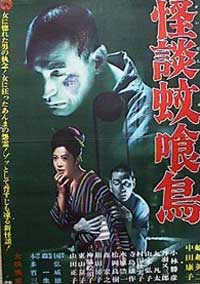 Kazuo Hase's Curse of the Blood aka Cruel Ghost Legend (Kaidan zankoku monogatari, Shochiku, 1968) is a tale of ghostly revenge. A samurai (Mutsuhiro Toura) slays a blind masseur (Nobuo Kaneko) when asked to return money loaned. Kazuo Hase's Curse of the Blood aka Cruel Ghost Legend (Kaidan zankoku monogatari, Shochiku, 1968) is a tale of ghostly revenge. A samurai (Mutsuhiro Toura) slays a blind masseur (Nobuo Kaneko) when asked to return money loaned.
Afterward, the samurai's sons & the blind masseur's daughters become entwined in a convoluted plot regarding the blood-curse which leads to numerous bloody deaths, incest, a ghostly manifestation, & ultimately suicide. A poster for this film is shown near this paragraph.
Kazuo Mori's Ghost Story of Kakui Street (Kaidan kokuidori, Daiei, 1961) features a haunted well with yet another blind masseur's vengeful ghost.
Nobuo Nakagawa's famous Yotsuya Ghost Story (Tokaido yotsuya kaidan, Shin Toho, 1959) is one of the best of numerous filmed versions of another kabuki play. It incorporates a slain blind masseur in addition to that famous story's usual ghost of a disfigured & murdered wife.
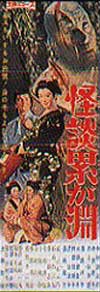 Films of the Yatsuya ghost story are considered in a separate article. But many elements recur in Kimiyoshi Yasuda's The Masseur's Curse; aka, The Horror of a Malformed Woman (Kaidan kasanegafuchi, Daiei, 1970). Films of the Yatsuya ghost story are considered in a separate article. But many elements recur in Kimiyoshi Yasuda's The Masseur's Curse; aka, The Horror of a Malformed Woman (Kaidan kasanegafuchi, Daiei, 1970).
It's a color remake of the same director's Depth of Kasana aka Ghost Story of Kasane (Kaidan kasane-ga-fuchi, 1960; poster for it is reproduced by this paragraph), starring Ganjiro Nakamura as the blind masseur, Yataro Kitagami, Nakata Yasuko, Yoko Uraji, et al. The black & white version is much better than the color remake, but the remake also has its charms.
The 1970 cast includes Ritsu Ishiyama, Maya Kitajima & Reiko Kasahara. A convoluted plot follows the murder of a money-lending masseur by an impoverished samurai. The slain masseur's daughter will also fall victim to his curse, so that she can become empowered as an agent of her father's vengeance.
Because the killer too soon commits suicide from guilt, the curse falls mainly to the murderer's son, who had nothing to do with the masseur's murder but is a pretty lousy son of a bitch in his own right. In the complicated tale that follows are ample opportunities for action & horror resulting from the masseur's curse, faithless love, a wife's hideous disfigurement of the young samurai's mistress who is the masseur's daughter, additional slayings & suicide.
The samurai is horrified by his wife's appearance, so leaves her, intent on running away with his mistress. Their path takes them through Kasane Swamp, where the corpse of the blind masseur had been discarded, providing one last horrific scene of vengeance.
There's less real justice in the masseur's revenge than in the ghost-wife's revenge in Yotsuya Ghost Story, but the similarities of these films to each other & to other kaidan can make them begin to feel pretty unoriginal after viewing a dozen takes.
These conventional ingredients go back at least to the late Tokugawa period kabuki theater, & probably much earlier in folklore & as "summer storytelling" entertainment, as spooky stories were intended to "chill" an audience in the hottest time of the year, around Bon Odori, a kind of summer Halloween when ghosts are appeased.
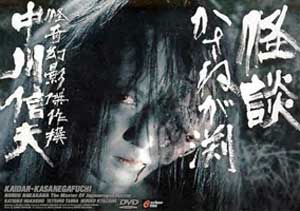 Nobuo Nakagawa's highly regarded 1957 version was Ghosts of Kasane Swamp aka The Depths (Kaidan kasanengafuchi, Shin Toho, 1957). Nobuo Nakagawa's highly regarded 1957 version was Ghosts of Kasane Swamp aka The Depths (Kaidan kasanengafuchi, Shin Toho, 1957).
This one has a highly artful presentation, with deeper motivation than usually conveyed by the character array, & a more exciting cast.
The plot is the same with its own variations. In 1733, Shinzaemon is a boozing samurai in the village of Hanya, Shimosa.
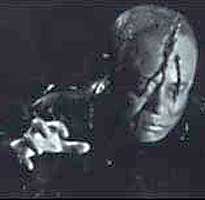 He cut down Soetsu the blind masseur for trying to collect on a debt of lent money. It was a brutal & grim slaying, as the masseur was a tough old bird. He cut down Soetsu the blind masseur for trying to collect on a debt of lent money. It was a brutal & grim slaying, as the masseur was a tough old bird.
The servant Kanzo was commanded to discard the corpse in the swamp. He gave the corpse a sickle with which to "fight off the demons & find your way to paradise."
The masseur's ghost haunts the samurai until he slays his own good wife Fusae (Fumiko Miyata). Upon her last breath she warns, "Fear the hatred of the dead!"
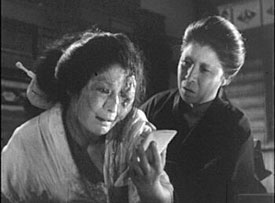 He cannot escape the haunting of a masseur's whistle. The blind man with bloody face appears to him everywhere. He cannot escape the haunting of a masseur's whistle. The blind man with bloody face appears to him everywhere.
Shinzaemon flees in terror into the swamp, sword drawn uselessly, & is caught in the muck, drawn into the depths of black water to drown.
Still unforgiving in the next generation, the curse of the masseur continues with the killer's son Shinkichi, raised by a shopkeeper.
Bad communication, love, & betrayal, make for complicated & painful relations between the schoolteacher Rui (Wakasugi Kazuko) who is the daughter of the blind man slain twenty years before, the shopkeeper's daughter Hisa (Kitazawa Noriko) with whom Shinichi (Wada Takashi) has an illicit tryst, Omura (Tetsura Tamba) a conniving violent ronin who who wants Rui for himself, & Rui's creepy old nurse.
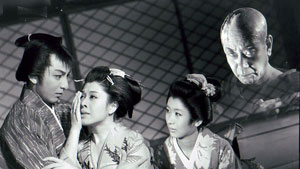 When Rui discovers Shinichi's faithlessness, she attempts murder, & commits suicide. When Rui discovers Shinichi's faithlessness, she attempts murder, & commits suicide.
She's doomed by the masseur's curse as though she weren't his own blood, for his spirit could never have permited fortunate love between his daughter & son of the man who killed him.
Hisa & Shinichi run away together, along a path that takes them through Kasane Swamp, where things go horribly wrong for them & double-suicide appears to be their only option. And when the ronin comes stalking after them, Rui will have her vengeance against him.
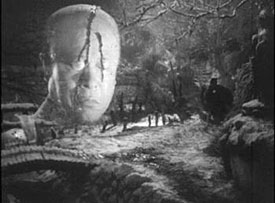 Films about the Kasane swamp ghost are based on a classic horror tale Shinkei Kasane-ga-fuchi by Encho Sanyuutei I, written about 1860. Films about the Kasane swamp ghost are based on a classic horror tale Shinkei Kasane-ga-fuchi by Encho Sanyuutei I, written about 1860.
The very first filmed version was Kenji Mizoguchi's Kyoren no onna shisho (Passion of a Female Teacher, 1926). It was the first of Mizoguchi's films to make it to Europe where it was well received, but alas I'm unaware that any print survives.
Other versions appeared as Kaidan kasane-ga-fuchi in 1930 directed by Buntaro Futagawa & 1937 directed by Hachiro Ogura; as Kaidan kyoren onna shisho directed by Mokuto Shigeru in 1939; as Kaidan iro zange: Kyoren onna shisho directed by Ryusuke Kurohashi in 1957.
Kazuo Hase's Kaidan zankoku monogatari (Shochiku, 1968) drew its story not from the classic tale, but from the horror novel by Renzaburo Shibata, creator also of the Kyoshiro Nemuri full moon swordsman character.
copyright © by Paghat the Ratgirl
|
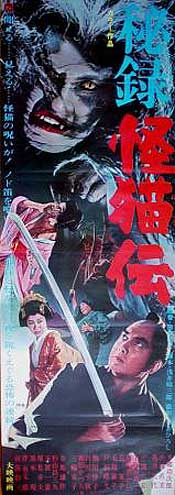

 During the monk's regular game of Go with the Lord, Matashichiro detects the effort of his Lord & lord's chamberlain (Mutsuhiro Toura) to cheat at the game of Go, but the chamerlain denies having removed a piece from the gameboard.
During the monk's regular game of Go with the Lord, Matashichiro detects the effort of his Lord & lord's chamberlain (Mutsuhiro Toura) to cheat at the game of Go, but the chamerlain denies having removed a piece from the gameboard.
 The story began to be adapted from the kabuki play to the screen as early as 1910 & almost annually throughout the silent era, & by the 1930s a continuous string of talkie versions were released.
The story began to be adapted from the kabuki play to the screen as early as 1910 & almost annually throughout the silent era, & by the 1930s a continuous string of talkie versions were released.
 This masterful version starred Bando Kotaru as Vassal Komori Hanzaemon who battles the demonic cat, & Takako Irie who plays the vengeful cat-ghost Otoyo.
This masterful version starred Bando Kotaru as Vassal Komori Hanzaemon who battles the demonic cat, & Takako Irie who plays the vengeful cat-ghost Otoyo. Quite a few other films tackle the theme of the cat of the "Nabeshime disturbance" but about most of them I know little or nothing, & some of which perhaps do not survive. I will merely list a few:
Quite a few other films tackle the theme of the cat of the "Nabeshime disturbance" but about most of them I know little or nothing, & some of which perhaps do not survive. I will merely list a few: Kazuo Hase's Curse of the Blood aka Cruel Ghost Legend (Kaidan zankoku monogatari, Shochiku, 1968) is a tale of ghostly revenge. A samurai (Mutsuhiro Toura) slays a blind masseur (Nobuo Kaneko) when asked to return money loaned.
Kazuo Hase's Curse of the Blood aka Cruel Ghost Legend (Kaidan zankoku monogatari, Shochiku, 1968) is a tale of ghostly revenge. A samurai (Mutsuhiro Toura) slays a blind masseur (Nobuo Kaneko) when asked to return money loaned.

 He cut down Soetsu the blind masseur for trying to collect on a debt of lent money. It was a brutal & grim slaying, as the masseur was a tough old bird.
He cut down Soetsu the blind masseur for trying to collect on a debt of lent money. It was a brutal & grim slaying, as the masseur was a tough old bird. He cannot escape the haunting of a masseur's whistle. The blind man with bloody face appears to him everywhere.
He cannot escape the haunting of a masseur's whistle. The blind man with bloody face appears to him everywhere. When Rui discovers Shinichi's faithlessness, she attempts murder, & commits suicide.
When Rui discovers Shinichi's faithlessness, she attempts murder, & commits suicide.